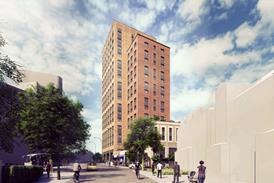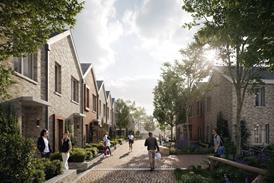Julia Park chews over the draft NPPF and Oliver Letwin’s initial report on housebuilding - and laments ministers’ woeful lack of aspiration

A senior civil servant once told me that the hallmark of a good policy is that everyone is equally aggrieved by it. This sums up the low expectations of our politicians and, eventually, ourselves. Much of what we hear is either managing expectation or damage limitation. The view is that as long as no one reacts really badly, it’s going well.
On that basis, the new draft NPPF is a success. Developers don’t like the prospect of making viability appraisals public or the suggestion that they are landbanking. Councils resent the fact that they are held responsible for housing delivery, but their own efforts to build are thwarted. Housing associations are content not to be criticised. And architects are resigned to the fact that they won’t get a look in.
Sure enough, the draft NPPF doesn’t mention architects or designers at all. It does talk about architecture and design but fails to make the link with design professionals. Other words that aren’t used include urban design, homelessness and social housing. Perhaps Grenfell hasn’t made much difference after all.
There are, as various commentators have said, some welcome changes. Viability appraisals will no longer be required where applications conform to local planning policy, and starter homes have been watered down to 10% of major developments. Paragraph 129 suggests that, ‘Permission should be refused for development of poor design that fails to take the opportunities available for improving the character and quality of an area and the way it functions, taking into account any local design standards in plans or supplementary planning documents’. The quid pro quo that, ‘..where the design of a development accords with clear expectations in local policies, design should not be used by the decision-maker as a valid reason to object to development’, puts the onus on planners to pin down what good design looks like.
Support for design review is lukewarm. ‘Local planning authorities should ensure that they have appropriate tools and processes for assessing and improving the design of development… In assessing applications, local planning authorities should have regard to the outcome from these processes, including any recommendations made by design review panels’. Hardly a ringing endorsement for what is often the only input from a qualified design professional that many schemes receive.
Accepting that they are very different documents, it’s difficult not to make comparisons with the new draft London Plan. The latter is bursting with ambition and a conviction that quality counts. Buildings are expected to be designed by professionals and post-planning retention of the architect is actively encouraged. Commitments to provide more social housing and social infrastructure, to promote inclusivity, improve air quality, reduce car usage, eradicate homelessness and achieve zero carbon are evident throughout. The downside is that, at 526 pages, the draft plan is almost eight times longer than the NPPF. I defy anyone to be alert, or even awake, by the end.
The NPPF is weak in comparison. The only mention of parking – the scourge of suburban streets – is to prohibit local authorities from setting maximum parking standards. You come away with the impression that lots more Poundburys (squashed up a bit to increase density) a few mansion blocks, plenty of permitted development and some upward extensions will do fine: just get on with it.
While a standardised approach to assessing housing need has always seemed sensible, I’m still baffled by the idea that, in areas of poor affordability, local authorities are required to build more housing than they actually need. Presumably, the thinking is that over-supply will bring down prices. True in theory, perhaps, but as these are generally the areas that are already struggling to meet demand, it’s hard to see how forcing them to build even more than they need is helpful.
Identifying ‘deliverable’ land for development and identifying housing need are two completely separate exercises and the results are very unlikely to align neatly in any given area. The glossary explains that, ‘to be considered deliverable, sites for housing should be available now, offer a suitable location for development now, and be achievable with a realistic prospect that housing will be delivered on the site within five years’. It’s difficult to believe that any land meeting these criteria would be languishing unnoticed or unused.
The government is leaving itself scope to react to Oliver Letwin’s ‘Review of Build Out’. His approach and his preliminary thoughts, set out in a letter to Hammond and Javid and published yesterday, are forthright. He feels that limited availability of skilled labour, building materials and capital, constrained logistics on site, delays caused by utility companies and difficulties of land remediation and provision of local transport infrastructure are all capable of causing delay at ‘stage 2’ (the build-out phase that starts with an implementable planning permission) and these will be investigated further. But Letwin has already concluded that they are not the primary determinants of build rates.
Instead, he blames the absorption rate, ‘..the rate at which newly constructed homes can be sold into (or are believed by the house-builder to be able to be sold successfully into) the local market without materially disturbing the market price’. He notes that the sale price of new homes is largely dictated by the price of comparable second-hand homes (a fact that would be unthinkable for every other industry you can imagine) and contests that the supply of affordable housing is constrained by the rate at which cross-subsidy becomes available from the open market housing. This bit puzzles me. Surely it’s in everyone’s interest for housing associations to take their share and pay their way as soon as possible? Unless, perhaps, there is a perception that having the affordable housing occupied early puts off buyers?
So much of the problem comes back to the way in which land is traded. It would help if planning authorities produced a detailed brief for all major sites as soon as they became available so developers knew exactly what would be acceptable and could gain planning permission quickly and easily. Even better if local authorities who assemble land gained planning approval before selling it on. Better still, to develop it themselves.
An ambitious government could do so much more. I keep wondering why Homes England couldn’t be funded to set up regional factories capable of producing thousands of architect-designed, tenure-neutral, modular homes with options to customise, use local labour to prepare the sites and construct the necessary infrastructure and transfer them to local authorities and housing associations to rent and sell.
Then I remember that not only do we not have any big thinkers, we have a secretary of state who has just returned £817m (earmarked for housing) to the Treasury because it wasn’t needed.
















No comments yet